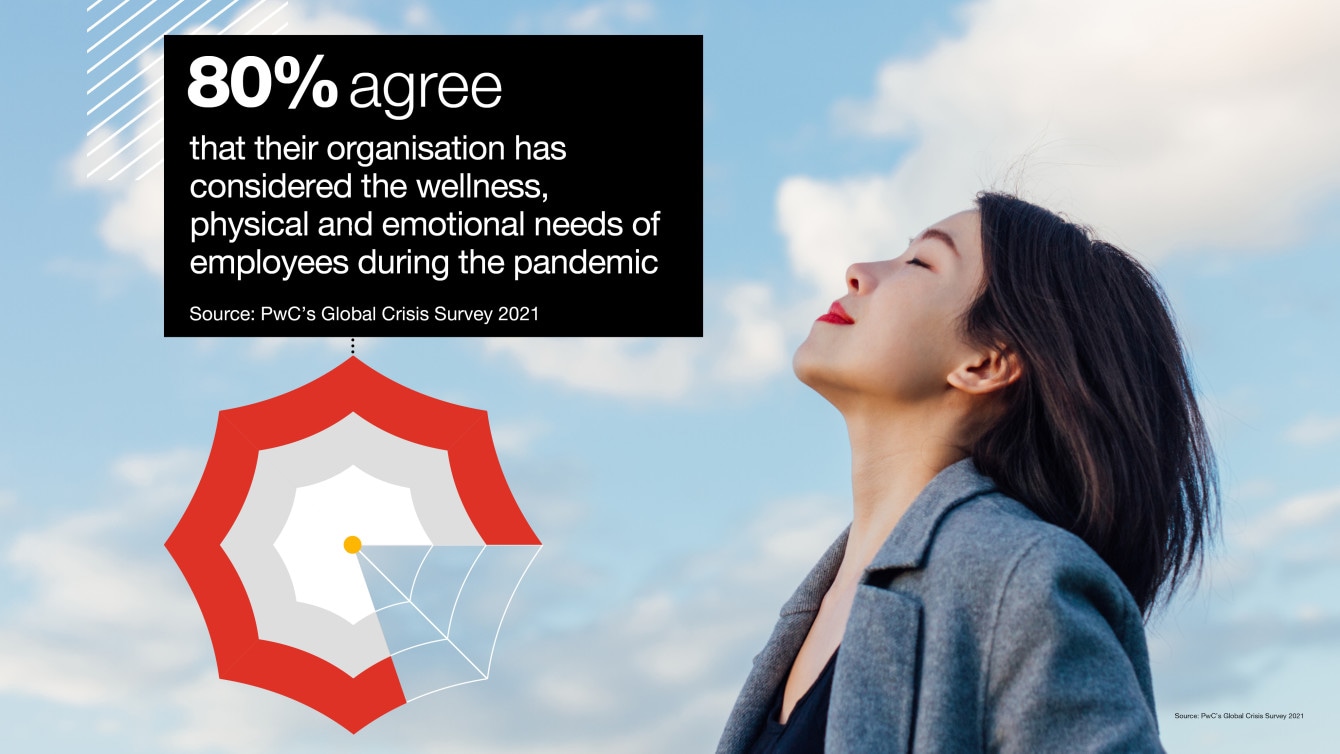Global Crisis Survey 2021
Building resilience for the future
PwC’s Global Crisis Survey 2021 examines the worldwide business community’s response to unprecedented social, economic and geopolitical disruption.
From altering corporate strategy to swiftly reshaping production capabilities, how did organisations react? How are businesses integrating what they’ve learned into a strategy for long-term resilience?

Video duration: 00:01:16
Charting a resilience roadmap for 2021
Between 20 August 2020 and 25 January 2021, organisations representing 73 countries and 29 industries shared their observations. This year’s Global Crisis Survey is our second collection of corporate crisis data and analysis.
The first, published in 2019, revealed that 95 percent of respondents believed a crisis was imminent within the next two years. But our list of potential crises didn’t include pandemic, which had dropped altogether from the threats business leaders said they feared. Until last year, the notion of a deadly virus igniting disruption worldwide wasn’t showing up on many radar screens, underscoring the very nature of crisis.
20% said the crisis had a positive overall impact on their organisation
But the challenge of crisis management is not to predict or measure every specific incident that could impact your business.
Rather, as 2020 dims in the rearview mirror, the inevitability and unpredictability of disruption have never been more clear. Businesses that prioritise and invest in building a foundation of resilience to address any type of crisis will be better positioned to weather what comes next.
Three takeaways
Business leaders recognise that a foundation of resilience can make the difference between faltering or flourishing — during a disruption or in good times. As the post-pandemic period begins to take shape in the coming months, organisations have an opportunity to reimagine opportunities for the future.
Emerging stronger from disruption
Some organisations are better off now than before the crisis began. How’d they do it?
Given the ongoing economic and political turbulence as the pandemic stretches into 2021, it might be surprising to find that 20 percent of Global Crisis Survey respondents said the crisis had a positive impact on their organisation. The reasons are myriad, including sector and region-specific factors. But a crisis can be a powerful catalyst for positive change.
What are those organisations doing differently?
Broadening their approach to risk and crisis, and applying a holistic strategy to organisational resilience by:
Thoroughly examining their response to the crisis
Incorporating insights and lessons learned into their long-term corporate strategy
Actively building muscle memory to strengthen preparation and response capabilities
At the tactical level, organisations that experienced positive impact share several commonalities. They were significantly more likely to say they’d given substantial attention to discussing organisational resilience.
Acting on those discussions is the next step. Not surprisingly, the better-off respondents were more likely to have taken action already on gaps or inconsistencies the crisis uncovered. Overall, two out of five respondents had not yet conducted a full after-action review, but 69 percent said they will have one in place for the next crisis.

Another benefit of self-examination? Confidence. Companies that conducted an after-action review were significantly more likely to say they are very confident of their ability to implement lessons learned. On the flip side, only 12 percent of those who did not conduct a review shared that assuredness.
Every crisis presents its own challenges — particularly a once-in-a-generation disruption. But with clear-eyed self-evaluation and a willingness to change, an organisation can build resilience to weather any kind of crisis and emerge stronger on the other side.
Then and now
Beginning in March 2020, PwC asked global business leaders whether they expected the COVID-19 pandemic to have a significant or critical impact on their organisations. The effect hasn’t been quite as severe in this regard as anticipated, but the fallout from the pandemic is historic, nonetheless — and its threats are still very real. Find out what business leaders said then, and what they say now.
‘What is the single most important action your organisation has taken so far in its response to COVID-19?’
A focus on wellness was the leading answer by a landslide to this survey question. From moving to remote work and implementing safety protocols, to assisting workers with personal hardship, organisations put the spotlight on supporting health and safety.
Some industries were hard-hit; others managed to innovate and thrive. Some countries, cities and towns have suffered exponentially more upheaval than others.
Overwhelmingly, though, business leaders across all sectors and territories said their most consequential move was to protect their teams: 80 percent agreed (32 percent strongly) that their response to the crisis took into consideration the physical and emotional needs of their employees.
In Singapore, a technology company endured significant financial losses but retained 100 percent of its employees. ‘The company has invested so much in our workforce,’ said the senior vice president, ‘and they continue to be an integral part of our company's recovery going forward.’
Organisations around the globe echoed that sentiment. In Australia, an industrial products firm launched a mental health program. A German automotive company’s assurances that jobs wouldn’t be cut, along with stronger organisational support, tightened the bonds between management and employees.
To be sure, promoting staff health is good business. As a US transportation and logistics company executive put it: ‘Once employees understood they were safe and comfortable, productivity zoomed.’
But with the entire world experiencing the collective trauma of illness and grief, lockdowns and quarantine, companies needed to adapt swiftly to keep business moving. For some organisations, that meant keeping their people safe at home — in some instances a wholly unfamiliar way of working.
A new personal resilience emerged as people dealt with unprecedented challenges: remote work and school, isolation from friends and extended family, and the endless adjustments, minor and monumental, wrought by the pandemic. That ability to adapt, to manage fundamental shifts in the way we live and work, is at the heart of individual and organisational resilience.

At a Canadian financial services firm, business leaders found value in acknowledging employees’ need for the ‘freedom and flexibility to perform their jobs while balancing against the changes in family lives.’ And a banking company leader in the United Kingdom said that ‘looking after staff and ensuring well-being and morale is top priority.’
How we fully emerge from the pandemic has yet to be written. But the common thread of organisations focusing on the wellness of their workers should continue when life — and business — gets back to normal.
How sectors have fared
Which sectors have taken the hardest hit?
%
Hospitality and Leisure
%
Higher Education
Organisations in these sectors experienced 'negative' and 'significant negative' impact:
Is ROI quantifiable in a crisis — even a disruption as devastating as the COVID-19 pandemic?
PwC’s Global Crisis Survey 2021 reinforces what we’ve learned over decades of supporting clients across every sector and through all types of disruption. With organisational resilience built into your DNA, you can emerge from a crisis stronger, prepared to secure new possibilities and ready to take on what’s next.












